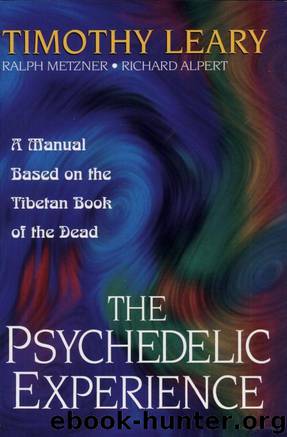Psychedelic Experience by Timothy Leary & Ralph Metzner & Richard Alpert

Author:Timothy Leary & Ralph Metzner & Richard Alpert
Language: eng
Format: azw3
Tags: Body, Social Science, Popular Culture, General, Comparative Religion, Religion, green_pill_short, Mind & Spirit, Parapsychology
ISBN: 9780902620216
Publisher: Academy Editions
Published: 1964-07-15T04:06:42.713304+00:00
Vision 7: “The Magic Theatre”
If the voyager was unable to maintain the passive serenity necessary for the contemplation of the previous visions (the peaceful deities), he moves now into a more dramatic and active phase. The play of forms and things becomes the play of heroic figures, superhuman spirits and demigods. [In the Tibetan Handbook, this is described as the vision of the five “Knowledge-Holding Deities,” arranged in a mandala form, each embraced by Dakinis, in an ecstatic dance. The Knowledge-holding Deities symbolize “the highest level of individual or humanly conceivable knowledge, as attained in the consciousness of great Yogis, inspired thinkers or similar heroes of the spirit. They represent the last step before the “breaking-through” towards the universal consciousness - or the first on the return from there to the plane of human knowledge.”
(Govinda, op. cit., p. 202.) The Dakinis are female embodiments of knowledge, representing the inspirational impluses of consciousness leading to break-through. The other four Knowledge-Holders, besides the central Lord of Dance, are: the Knowledge-holder abiding in the earth, the Knowledge-holder who has power over the duration of life, the Knowledge-holder of the Great Symbol, and the Knowledge-holder of Spontaneous Realization.] You may see radiating figures in human forms. The “Lotus Lord of Dance”: the supreme image of a demi-god who perceives the effects of all actions. The prince of movement, dancing in an ecstatic embrace with his female counterpart. Heroes, heroines, celestial warriors, male and female demi-gods, angels, fairies - the exact form of these figures will depend on the person’s background and tradition. Archetypal figures in the forms of characters from Greek, Egyptian, Nordic, Celtic, Aztec, Persian, Indian, Chinese mythology. The shapes differ, the source is the same: they are the concrete embodiments of aspects of the person’s own psyche. Archetypal forces below verbal awareness and expressible only in symbolic form. The figures are often extremely colorful and accompanied by a variety of awe-inspiring sounds. If the voyager is prepared and in a relaxed, detached frame of mind, he is exposed to a fascinating and dazzling display of dramatic creativity. The Cosmic Theatre. The Divine Comedy. If his eyes are open, he may visualize the other voyagers as representing these figures. The face of a friend may turn into that of a young boy, a baby, the child-god; into a heroic stature, a wise old man; a woman, animal, goddess, sea-mother, young girl, nymph, elf, goblin, leprechaun. Images of the great painters arise as the familiar representations of these spirits. The images are inexhaustible and manifold. An illuminating voyage into the areas where the personal consciousness merges with the supr-individual.
The danger is that the voyager becomes frightened by or unduly attracted to these powerful figures. The forces represented by them may be more intense than he was prepared for. Inability or unwillingness to recognize them as products of one’s mind, leads to escape into animalistic pursuits. The person may become involved in the pursuit of power, lust, wealth and descend into Third Bardo rebirth struggles.
If
Download
This site does not store any files on its server. We only index and link to content provided by other sites. Please contact the content providers to delete copyright contents if any and email us, we'll remove relevant links or contents immediately.
| Confucianism | Feng Shui |
| I Ching | Jainism |
| Karma | Shintoism |
| Sikhism | Tao Te Ching |
| Taoism | Tibetan Book of the Dead |
| Zoroastrianism |
The Tao of Physics by Fritjof Capra(2233)
Human Design by Chetan Parkyn(2034)
The Diamond Cutter by Geshe Michael Roach(2023)
Feng Shui by Stephen Skinner(1904)
The Alchemy of Sexual Energy by Mantak Chia(1819)
Tao Te Ching by Lao Tzu(1807)
365 Tao: Daily Meditations by Ming-Dao Deng(1591)
Tao Tantric Arts for Women by Minke de Vos(1550)
Sun Tzu's The Art of War by Giles Lionel Minford John Tzu Sun(1508)
Sidney Sheldon (1982) Master Of The Game by Sidney Sheldon(1476)
Buddhism 101 by Arnie Kozak(1473)
Karma-Yoga and Bhakti-Yoga by Swami Vivekananda(1471)
The Analects of Confucius by Burton Watson(1397)
The Art of War Other Classics of Eastern Philosophy by Sun Tzu Lao-Tzu Confucius Mencius(1378)
Tao te ching by Lao Tzu(1333)
The Way of Chuang Tzu by Thomas Merton(1330)
The New Bohemians Handbook by Justina Blakeney(1322)
The Sayings Of by Confucius(1283)
Bless This House by Donna Henes(1238)
